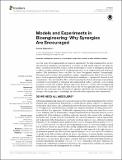| dc.contributor.author | Malandrino, Andrea | |
| dc.date.accessioned | 2016-03-16T16:32:27Z | |
| dc.date.available | 2016-03-16T16:32:27Z | |
| dc.date.issued | 2016-01 | |
| dc.date.submitted | 2015-10 | |
| dc.identifier.issn | 2296-4185 | |
| dc.identifier.uri | http://hdl.handle.net/1721.1/101718 | |
| dc.description.abstract | Does the future of bioengineering lie in models or experiments? The long-standing debate on how and how much experimental and theoretical research in our field should cooperate can shape the future. This debate means often a choice, early in the bioengineer’s career. A bioengineer may prefer to address scientific questions based on experimental tests, or on computational and theoretical analyses. This fundamental choice can drive the future bioengineer’s mindset. Unsurprisingly, laboratories and researchers often assemble in separate, competitive teams. Indeed, the way bioengineers tackle a question is shaped by the characteristic techniques – experimental, theoretical, and computational – they are trained for. Here, without neglecting the obvious advantages of specializing exclusively in experimental, or theoretical and computational studies, I advocate a way of doing synergistic research that combine different approaches. Moreover, I believe that bioengineering desperately needs synergy and cooperation to pave the way for significant discoveries. We need efforts to train a new generation of biomedical engineers: individuals who take advantage of these synergies, who design projects accordingly, and who make these approaches work cooperatively. | en_US |
| dc.description.sponsorship | Seventh Framework Programme (European Commission) (Marie Sklodowska-Curie International Outgoing Fellowship Grant PIOF-GA-2013-625500) | en_US |
| dc.language.iso | en_US | |
| dc.publisher | Frontiers Research Foundation | en_US |
| dc.relation.isversionof | http://dx.doi.org/10.3389/fbioe.2015.00207 | en_US |
| dc.rights | Creative Commons Attribution | en_US |
| dc.rights.uri | http://creativecommons.org/licenses/by/4.0/ | en_US |
| dc.source | Frontiers Research Foundation | en_US |
| dc.title | Models and Experiments in Bioengineering: Why Synergies Are Encouraged | en_US |
| dc.type | Article | en_US |
| dc.identifier.citation | Malandrino, Andrea. “Models and Experiments in Bioengineering: Why Synergies Are Encouraged.” Frontiers in Bioengineering and Biotechnology 3 (January 11, 2016). | en_US |
| dc.contributor.department | Massachusetts Institute of Technology. Department of Mechanical Engineering | en_US |
| dc.contributor.mitauthor | Malandrino, Andrea | en_US |
| dc.relation.journal | Frontiers in Bioengineering and Biotechnology | en_US |
| dc.eprint.version | Final published version | en_US |
| dc.type.uri | http://purl.org/eprint/type/JournalArticle | en_US |
| eprint.status | http://purl.org/eprint/status/PeerReviewed | en_US |
| dspace.orderedauthors | Malandrino, Andrea | en_US |
| dc.identifier.orcid | https://orcid.org/0000-0002-7928-0951 | |
| mit.license | PUBLISHER_CC | en_US |
